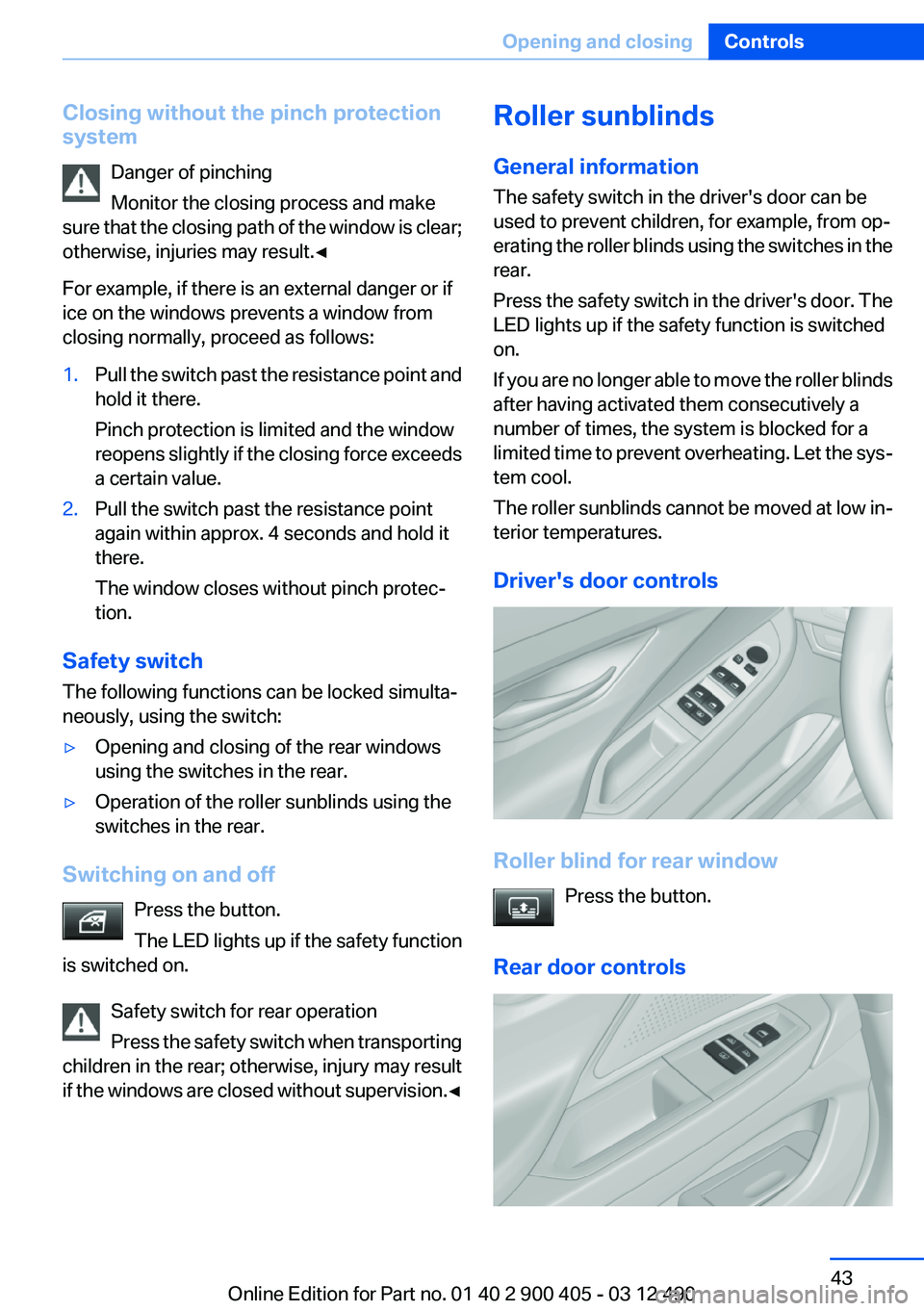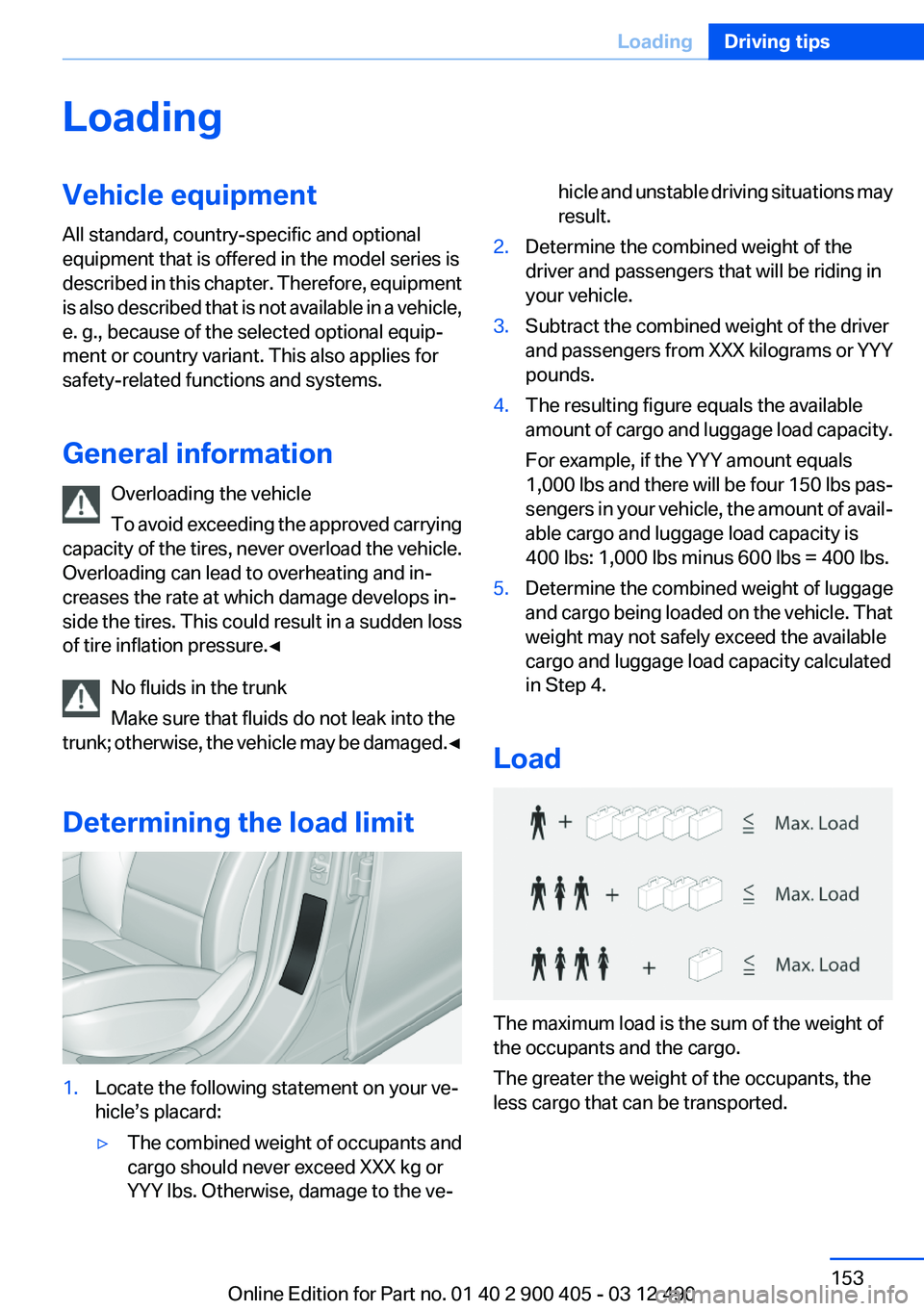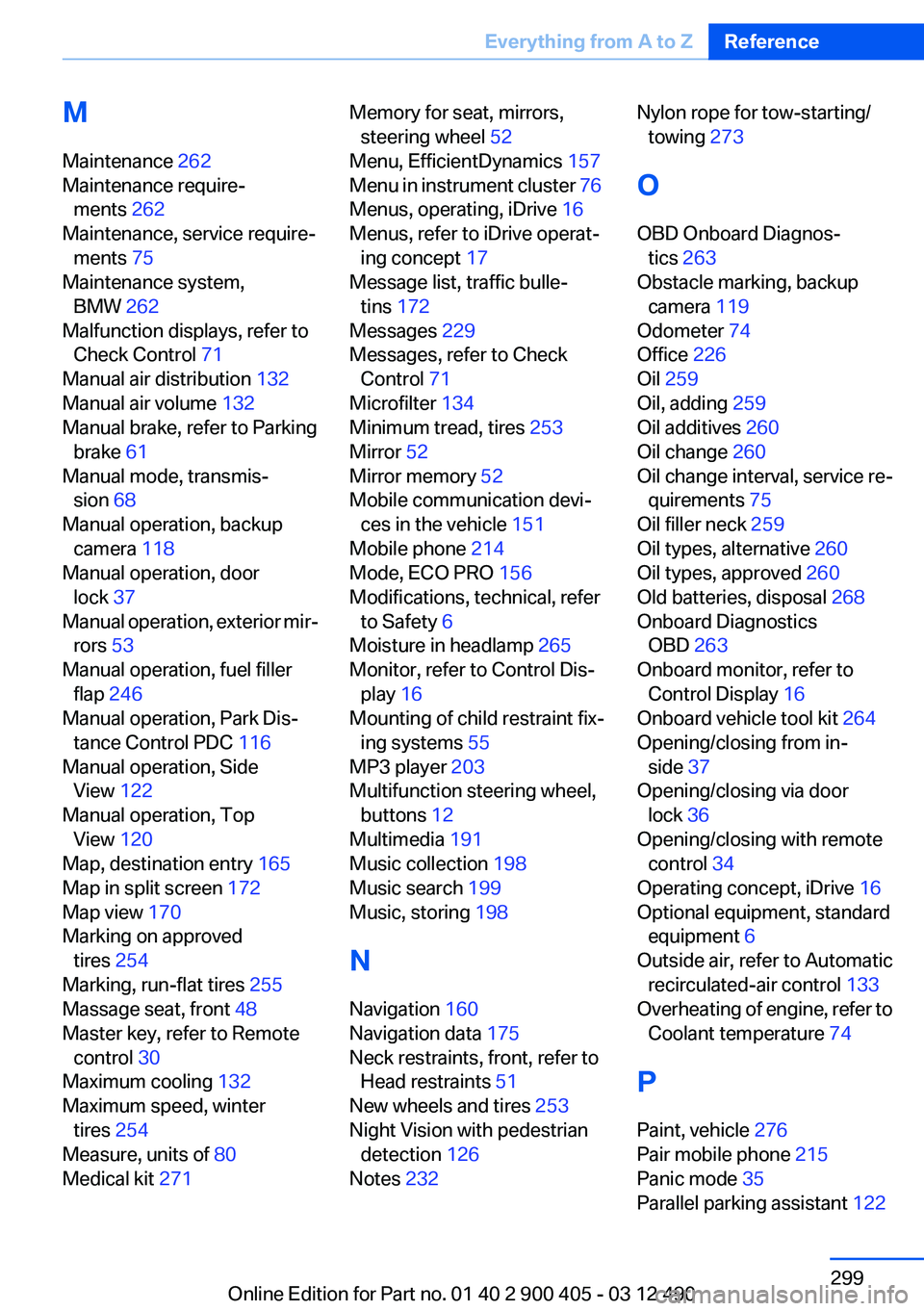2013 BMW 640I GRAN COUPE overheating
[x] Cancel search: overheatingPage 43 of 305

Closing without the pinch protection
system
Danger of pinching
Monitor the closing process and make
sure that the closing path of the window is clear;
otherwise, injuries may result.◀
For example, if there is an external danger or if
ice on the windows prevents a window from
closing normally, proceed as follows:1.Pull the switch past the resistance point and
hold it there.
Pinch protection is limited and the window
reopens slightly if the closing force exceeds
a certain value.2.Pull the switch past the resistance point
again within approx. 4 seconds and hold it
there.
The window closes without pinch protec‐
tion.
Safety switch
The following functions can be locked simulta‐
neously, using the switch:
▷Opening and closing of the rear windows
using the switches in the rear.▷Operation of the roller sunblinds using the
switches in the rear.
Switching on and off
Press the button.
The LED lights up if the safety function
is switched on.
Safety switch for rear operation
Press the safety switch when transporting
children in the rear; otherwise, injury may result
if the windows are closed without supervision. ◀
Roller sunblinds
General information
The safety switch in the driver's door can be
used to prevent children, for example, from op‐
erating the roller blinds using the switches in the
rear.
Press the safety switch in the driver's door. The
LED lights up if the safety function is switched
on.
If you are no longer able to move the roller blinds
after having activated them consecutively a
number of times, the system is blocked for a
limited time to prevent overheating. Let the sys‐
tem cool.
The roller sunblinds cannot be moved at low in‐
terior temperatures.
Driver's door controls
Roller blind for rear window Press the button.
Rear door controls
Seite 43Opening and closingControls43
Online Edition for Part no. 01 40 2 900 405 - 03 12 490
Page 153 of 305

LoadingVehicle equipment
All standard, country-specific and optional
equipment that is offered in the model series is
described in this chapter. Therefore, equipment
is also described that is not available in a vehicle,
e. g., because of the selected optional equip‐
ment or country variant. This also applies for
safety-related functions and systems.
General information Overloading the vehicle
To avoid exceeding the approved carrying
capacity of the tires, never overload the vehicle.
Overloading can lead to overheating and in‐
creases the rate at which damage develops in‐
side the tires. This could result in a sudden loss
of tire inflation pressure.◀
No fluids in the trunk
Make sure that fluids do not leak into the
trunk; otherwise, the vehicle may be damaged. ◀
Determining the load limit1.Locate the following statement on your ve‐
hicle’s placard:▷The combined weight of occupants and
cargo should never exceed XXX kg or
YYY lbs. Otherwise, damage to the ve‐hicle and unstable driving situations may
result.2.Determine the combined weight of the
driver and passengers that will be riding in
your vehicle.3.Subtract the combined weight of the driver
and passengers from XXX kilograms or YYY
pounds.4.The resulting figure equals the available
amount of cargo and luggage load capacity.
For example, if the YYY amount equals
1,000 lbs and there will be four 150 lbs pas‐
sengers in your vehicle, the amount of avail‐
able cargo and luggage load capacity is
400 lbs: 1,000 lbs minus 600 lbs = 400 lbs.5.Determine the combined weight of luggage
and cargo being loaded on the vehicle. That
weight may not safely exceed the available
cargo and luggage load capacity calculated
in Step 4.
Load
The maximum load is the sum of the weight of
the occupants and the cargo.
The greater the weight of the occupants, the
less cargo that can be transported.
Seite 153LoadingDriving tips153
Online Edition for Part no. 01 40 2 900 405 - 03 12 490
Page 299 of 305

M
Maintenance 262
Maintenance require‐ ments 262
Maintenance, service require‐ ments 75
Maintenance system, BMW 262
Malfunction displays, refer to Check Control 71
Manual air distribution 132
Manual air volume 132
Manual brake, refer to Parking brake 61
Manual mode, transmis‐ sion 68
Manual operation, backup camera 118
Manual operation, door lock 37
Manual operation, exterior mir‐ rors 53
Manual operation, fuel filler flap 246
Manual operation, Park Dis‐ tance Control PDC 116
Manual operation, Side View 122
Manual operation, Top View 120
Map, destination entry 165
Map in split screen 172
Map view 170
Marking on approved tires 254
Marking, run-flat tires 255
Massage seat, front 48
Master key, refer to Remote control 30
Maximum cooling 132
Maximum speed, winter tires 254
Measure, units of 80
Medical kit 271 Memory for seat, mirrors,
steering wheel 52
Menu, EfficientDynamics 157
Menu in instrument cluster 76
Menus, operating, iDrive 16
Menus, refer to iDrive operat‐ ing concept 17
Message list, traffic bulle‐ tins 172
Messages 229
Messages, refer to Check Control 71
Microfilter 134
Minimum tread, tires 253
Mirror 52
Mirror memory 52
Mobile communication devi‐ ces in the vehicle 151
Mobile phone 214
Mode, ECO PRO 156
Modifications, technical, refer to Safety 6
Moisture in headlamp 265
Monitor, refer to Control Dis‐ play 16
Mounting of child restraint fix‐ ing systems 55
MP3 player 203
Multifunction steering wheel, buttons 12
Multimedia 191
Music collection 198
Music search 199
Music, storing 198
N
Navigation 160
Navigation data 175
Neck restraints, front, refer to Head restraints 51
New wheels and tires 253
Night Vision with pedestrian detection 126
Notes 232 Nylon rope for tow-starting/
towing 273
O
OBD Onboard Diagnos‐ tics 263
Obstacle marking, backup camera 119
Odometer 74
Office 226
Oil 259
Oil, adding 259
Oil additives 260
Oil change 260
Oil change interval, service re‐ quirements 75
Oil filler neck 259
Oil types, alternative 260
Oil types, approved 260
Old batteries, disposal 268
Onboard Diagnostics OBD 263
Onboard monitor, refer to Control Display 16
Onboard vehicle tool kit 264
Opening/closing from in‐ side 37
Opening/closing via door lock 36
Opening/closing with remote control 34
Operating concept, iDrive 16
Optional equipment, standard equipment 6
Outside air, refer to Automatic recirculated-air control 133
Overheating of engine, refer to Coolant temperature 74
P
Paint, vehicle 276
Pair mobile phone 215
Panic mode 35
Parallel parking assistant 122 Seite 299Everything from A to ZReference299
Online Edition for Part no. 01 40 2 900 405 - 03 12 490